ENGL 1213: Analyzing Rhetorical Devices in King's 'Break Silence'
VerifiedAdded on 2023/06/15
|5
|953
|404
Essay
AI Summary
This essay presents a rhetorical analysis of Martin Luther King Jr.'s "A Time to Break Silence" speech, delivered on April 4, 1967. The essay identifies the speech's central argument against the Vietnam War, highlighting King's use of logical reasoning (logos), emotional appeals (pathos), and limited appeals to credibility (ethos) to persuade his audience. It examines how King strategically employs these rhetorical devices to critique American governmental policies and advocate for peace and social justice. The analysis evaluates the effectiveness of King's appeals in conveying his message and challenging the prevailing pro-war sentiment, ultimately reinforcing the speech's call for moral responsibility and action. Desklib is a platform where students can find similar essays and study resources.
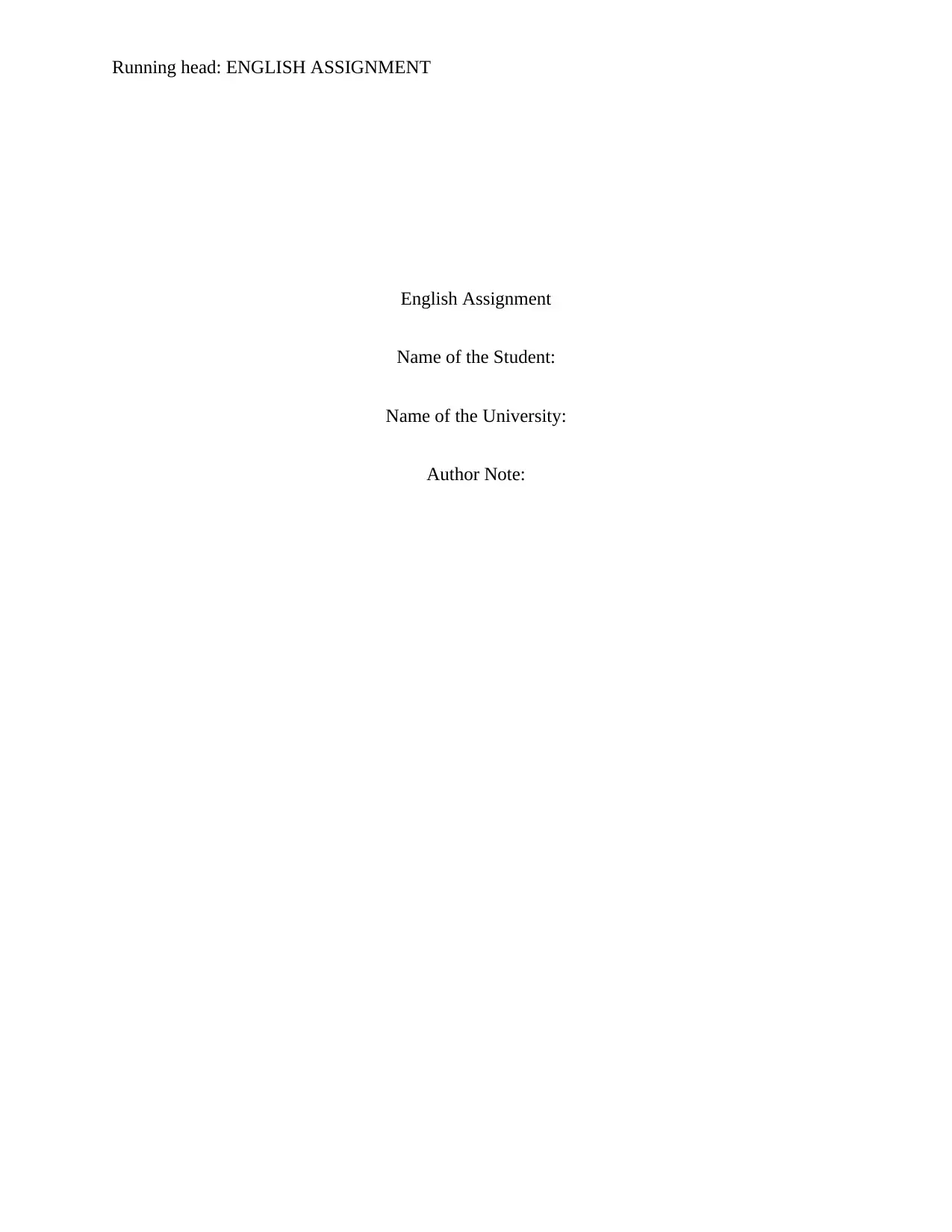
Running head: ENGLISH ASSIGNMENT
English Assignment
Name of the Student:
Name of the University:
Author Note:
English Assignment
Name of the Student:
Name of the University:
Author Note:
Paraphrase This Document
Need a fresh take? Get an instant paraphrase of this document with our AI Paraphraser
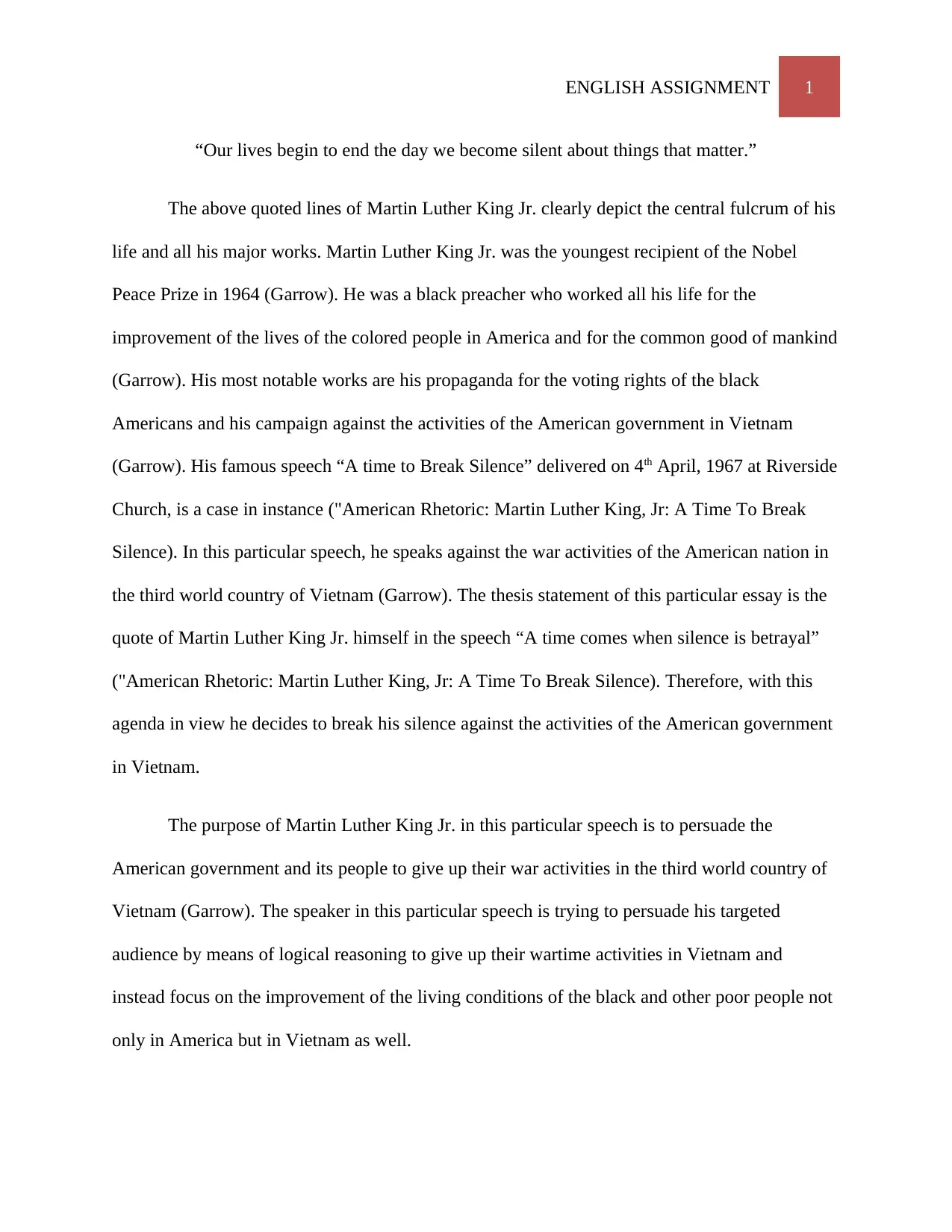
ENGLISH ASSIGNMENT 1
“Our lives begin to end the day we become silent about things that matter.”
The above quoted lines of Martin Luther King Jr. clearly depict the central fulcrum of his
life and all his major works. Martin Luther King Jr. was the youngest recipient of the Nobel
Peace Prize in 1964 (Garrow). He was a black preacher who worked all his life for the
improvement of the lives of the colored people in America and for the common good of mankind
(Garrow). His most notable works are his propaganda for the voting rights of the black
Americans and his campaign against the activities of the American government in Vietnam
(Garrow). His famous speech “A time to Break Silence” delivered on 4th April, 1967 at Riverside
Church, is a case in instance ("American Rhetoric: Martin Luther King, Jr: A Time To Break
Silence). In this particular speech, he speaks against the war activities of the American nation in
the third world country of Vietnam (Garrow). The thesis statement of this particular essay is the
quote of Martin Luther King Jr. himself in the speech “A time comes when silence is betrayal”
("American Rhetoric: Martin Luther King, Jr: A Time To Break Silence). Therefore, with this
agenda in view he decides to break his silence against the activities of the American government
in Vietnam.
The purpose of Martin Luther King Jr. in this particular speech is to persuade the
American government and its people to give up their war activities in the third world country of
Vietnam (Garrow). The speaker in this particular speech is trying to persuade his targeted
audience by means of logical reasoning to give up their wartime activities in Vietnam and
instead focus on the improvement of the living conditions of the black and other poor people not
only in America but in Vietnam as well.
“Our lives begin to end the day we become silent about things that matter.”
The above quoted lines of Martin Luther King Jr. clearly depict the central fulcrum of his
life and all his major works. Martin Luther King Jr. was the youngest recipient of the Nobel
Peace Prize in 1964 (Garrow). He was a black preacher who worked all his life for the
improvement of the lives of the colored people in America and for the common good of mankind
(Garrow). His most notable works are his propaganda for the voting rights of the black
Americans and his campaign against the activities of the American government in Vietnam
(Garrow). His famous speech “A time to Break Silence” delivered on 4th April, 1967 at Riverside
Church, is a case in instance ("American Rhetoric: Martin Luther King, Jr: A Time To Break
Silence). In this particular speech, he speaks against the war activities of the American nation in
the third world country of Vietnam (Garrow). The thesis statement of this particular essay is the
quote of Martin Luther King Jr. himself in the speech “A time comes when silence is betrayal”
("American Rhetoric: Martin Luther King, Jr: A Time To Break Silence). Therefore, with this
agenda in view he decides to break his silence against the activities of the American government
in Vietnam.
The purpose of Martin Luther King Jr. in this particular speech is to persuade the
American government and its people to give up their war activities in the third world country of
Vietnam (Garrow). The speaker in this particular speech is trying to persuade his targeted
audience by means of logical reasoning to give up their wartime activities in Vietnam and
instead focus on the improvement of the living conditions of the black and other poor people not
only in America but in Vietnam as well.
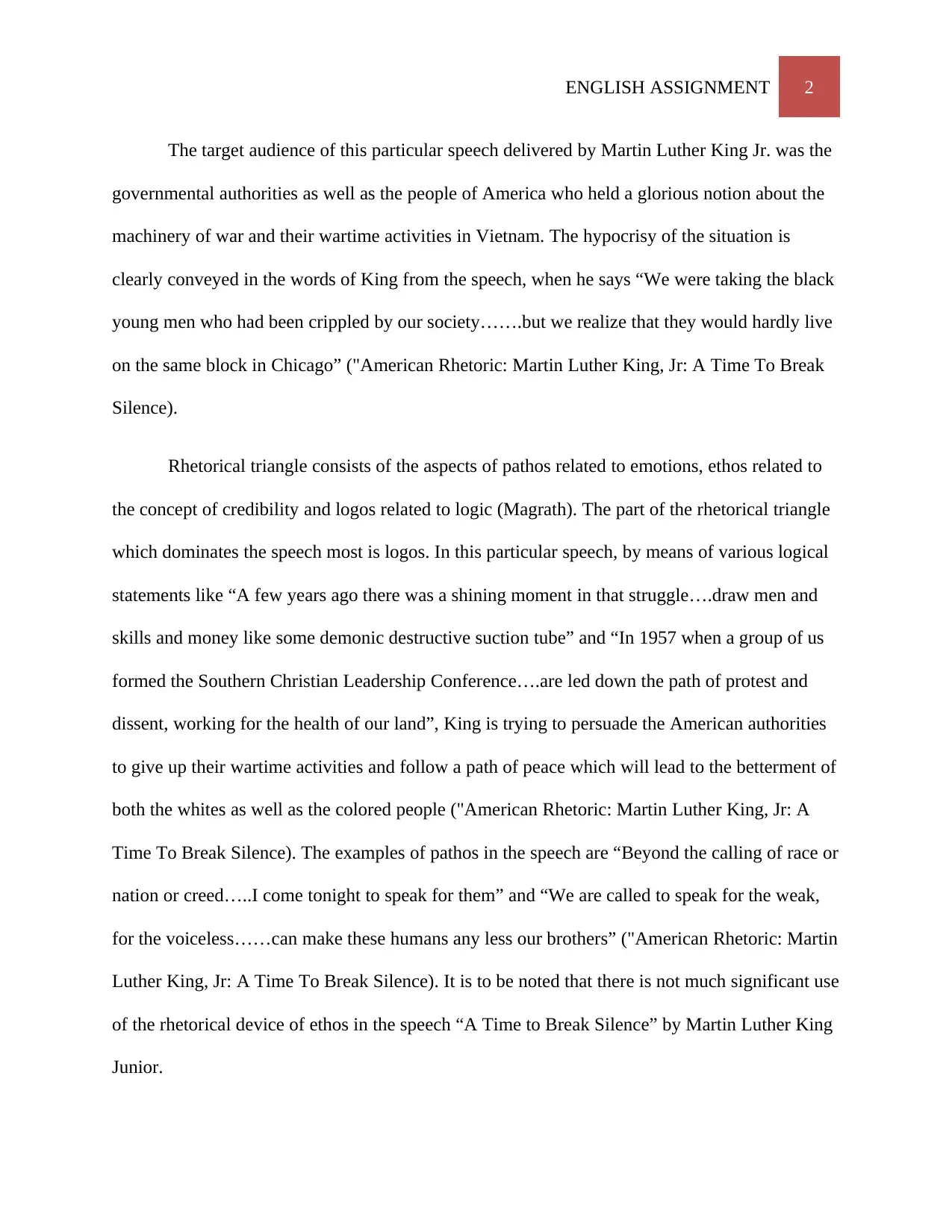
ENGLISH ASSIGNMENT 2
The target audience of this particular speech delivered by Martin Luther King Jr. was the
governmental authorities as well as the people of America who held a glorious notion about the
machinery of war and their wartime activities in Vietnam. The hypocrisy of the situation is
clearly conveyed in the words of King from the speech, when he says “We were taking the black
young men who had been crippled by our society…….but we realize that they would hardly live
on the same block in Chicago” ("American Rhetoric: Martin Luther King, Jr: A Time To Break
Silence).
Rhetorical triangle consists of the aspects of pathos related to emotions, ethos related to
the concept of credibility and logos related to logic (Magrath). The part of the rhetorical triangle
which dominates the speech most is logos. In this particular speech, by means of various logical
statements like “A few years ago there was a shining moment in that struggle….draw men and
skills and money like some demonic destructive suction tube” and “In 1957 when a group of us
formed the Southern Christian Leadership Conference….are led down the path of protest and
dissent, working for the health of our land”, King is trying to persuade the American authorities
to give up their wartime activities and follow a path of peace which will lead to the betterment of
both the whites as well as the colored people ("American Rhetoric: Martin Luther King, Jr: A
Time To Break Silence). The examples of pathos in the speech are “Beyond the calling of race or
nation or creed…..I come tonight to speak for them” and “We are called to speak for the weak,
for the voiceless……can make these humans any less our brothers” ("American Rhetoric: Martin
Luther King, Jr: A Time To Break Silence). It is to be noted that there is not much significant use
of the rhetorical device of ethos in the speech “A Time to Break Silence” by Martin Luther King
Junior.
The target audience of this particular speech delivered by Martin Luther King Jr. was the
governmental authorities as well as the people of America who held a glorious notion about the
machinery of war and their wartime activities in Vietnam. The hypocrisy of the situation is
clearly conveyed in the words of King from the speech, when he says “We were taking the black
young men who had been crippled by our society…….but we realize that they would hardly live
on the same block in Chicago” ("American Rhetoric: Martin Luther King, Jr: A Time To Break
Silence).
Rhetorical triangle consists of the aspects of pathos related to emotions, ethos related to
the concept of credibility and logos related to logic (Magrath). The part of the rhetorical triangle
which dominates the speech most is logos. In this particular speech, by means of various logical
statements like “A few years ago there was a shining moment in that struggle….draw men and
skills and money like some demonic destructive suction tube” and “In 1957 when a group of us
formed the Southern Christian Leadership Conference….are led down the path of protest and
dissent, working for the health of our land”, King is trying to persuade the American authorities
to give up their wartime activities and follow a path of peace which will lead to the betterment of
both the whites as well as the colored people ("American Rhetoric: Martin Luther King, Jr: A
Time To Break Silence). The examples of pathos in the speech are “Beyond the calling of race or
nation or creed…..I come tonight to speak for them” and “We are called to speak for the weak,
for the voiceless……can make these humans any less our brothers” ("American Rhetoric: Martin
Luther King, Jr: A Time To Break Silence). It is to be noted that there is not much significant use
of the rhetorical device of ethos in the speech “A Time to Break Silence” by Martin Luther King
Junior.
⊘ This is a preview!⊘
Do you want full access?
Subscribe today to unlock all pages.

Trusted by 1+ million students worldwide
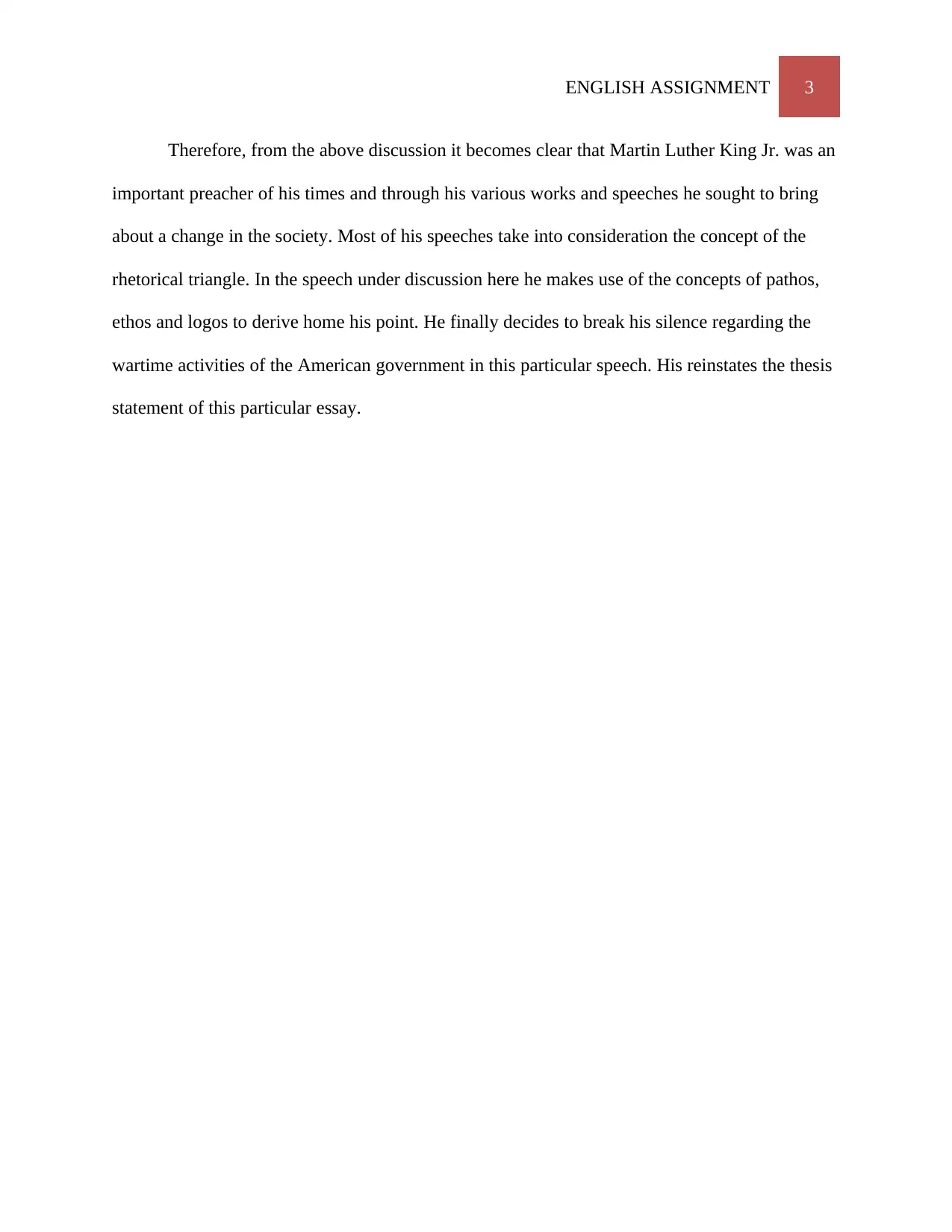
ENGLISH ASSIGNMENT 3
Therefore, from the above discussion it becomes clear that Martin Luther King Jr. was an
important preacher of his times and through his various works and speeches he sought to bring
about a change in the society. Most of his speeches take into consideration the concept of the
rhetorical triangle. In the speech under discussion here he makes use of the concepts of pathos,
ethos and logos to derive home his point. He finally decides to break his silence regarding the
wartime activities of the American government in this particular speech. His reinstates the thesis
statement of this particular essay.
Therefore, from the above discussion it becomes clear that Martin Luther King Jr. was an
important preacher of his times and through his various works and speeches he sought to bring
about a change in the society. Most of his speeches take into consideration the concept of the
rhetorical triangle. In the speech under discussion here he makes use of the concepts of pathos,
ethos and logos to derive home his point. He finally decides to break his silence regarding the
wartime activities of the American government in this particular speech. His reinstates the thesis
statement of this particular essay.
Paraphrase This Document
Need a fresh take? Get an instant paraphrase of this document with our AI Paraphraser
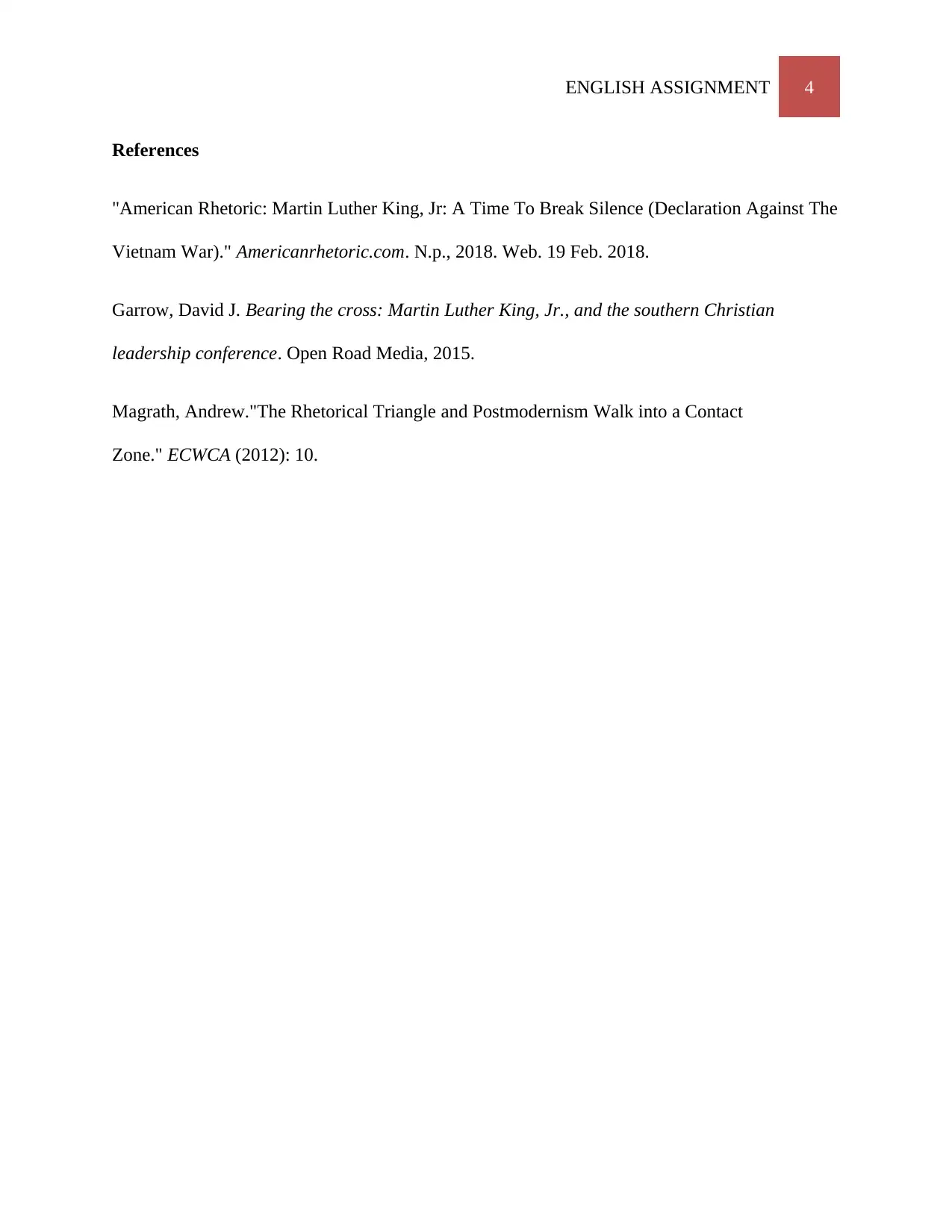
ENGLISH ASSIGNMENT 4
References
"American Rhetoric: Martin Luther King, Jr: A Time To Break Silence (Declaration Against The
Vietnam War)." Americanrhetoric.com. N.p., 2018. Web. 19 Feb. 2018.
Garrow, David J. Bearing the cross: Martin Luther King, Jr., and the southern Christian
leadership conference. Open Road Media, 2015.
Magrath, Andrew."The Rhetorical Triangle and Postmodernism Walk into a Contact
Zone." ECWCA (2012): 10.
References
"American Rhetoric: Martin Luther King, Jr: A Time To Break Silence (Declaration Against The
Vietnam War)." Americanrhetoric.com. N.p., 2018. Web. 19 Feb. 2018.
Garrow, David J. Bearing the cross: Martin Luther King, Jr., and the southern Christian
leadership conference. Open Road Media, 2015.
Magrath, Andrew."The Rhetorical Triangle and Postmodernism Walk into a Contact
Zone." ECWCA (2012): 10.
1 out of 5
Your All-in-One AI-Powered Toolkit for Academic Success.
+13062052269
info@desklib.com
Available 24*7 on WhatsApp / Email
![[object Object]](/_next/static/media/star-bottom.7253800d.svg)
Unlock your academic potential
Copyright © 2020–2025 A2Z Services. All Rights Reserved. Developed and managed by ZUCOL.


